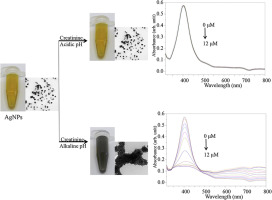当前位置:
X-MOL 学术
›
Anal. Chim. Acta
›
论文详情
Our official English website, www.x-mol.net, welcomes your
feedback! (Note: you will need to create a separate account there.)
Citrate-capped silver nanoparticles as a probe for sensitive and selective colorimetric and spectrophotometric sensing of creatinine in human urine
Analytica Chimica Acta ( IF 5.7 ) Pub Date : 2018-05-01 , DOI: 10.1016/j.aca.2017.12.016 Melisew Tadele Alula , Leshern Karamchand , Nicolette R. Hendricks , Jonathan M. Blackburn
Analytica Chimica Acta ( IF 5.7 ) Pub Date : 2018-05-01 , DOI: 10.1016/j.aca.2017.12.016 Melisew Tadele Alula , Leshern Karamchand , Nicolette R. Hendricks , Jonathan M. Blackburn

|
Urinary creatinine concentration is a critical physiological parameter that enables reliable assessment of patient renal function and diagnosis of a broad spectrum of diseases. In this study, a simple and inexpensive sensor comprising monodisperse, citrate-capped silver nanoparticles (cc-AgNPs) was developed, which enabled rapid, sensitive and selective quantitation of creatinine directly in unprocessed urine. The mechanism of this sensor entails the creatinine-mediated aggregation of the cc-AgNPs (within 1 min) under alkaline conditions (pH 12). This is attributed to the tautomerization of creatinine to its amino anionic species at alkaline pH, which cross-link the cc-AgNPs via hydrogen bond networks with the negatively charged citrate caps. Creatinine elicited visibly-discernable color changes of the cc-AgNPs colloids in a concentration-dependent manner up to 10 μM. UV-visible spectroscopic analyses of the cc-AgNPs revealed that creatinine elicited a concentration-dependent decrease in intensity of the localized surface plasmon resonance (LSPR) band centered around 403 nm, with a concomitant increase in intensity of the red-shifted LSPR band at 670 nm. This observation denotes a creatinine-mediated increase in cc-AgNP particle size via aggregation, as confirmed by transmission electron microscopy analysis. The cc-AgNP sensor exhibited a linear correlation between the A670/A403 extinction ratio and creatinine concentration range of 0-4.2 μM in aqueous solutions (R2 = 0.996), and a low detection limit of 53.4 nM. Hence, the simplicity, short assay time, and high sensitivity and selectivity of our cc-AgNP sensor affirms its utility as a creatinine monitoring assay for low-resource, point-of-care settings.
中文翻译:

柠檬酸盐封端的银纳米颗粒作为探针用于人尿中肌酐的灵敏和选择性比色和分光光度检测
尿肌酐浓度是一个关键的生理参数,可以可靠地评估患者的肾功能和诊断多种疾病。在这项研究中,开发了一种简单且廉价的传感器,该传感器包含单分散、柠檬酸盐封端的银纳米粒子 (cc-AgNPs),它能够直接在未处理的尿液中快速、灵敏和选择性地定量肌酐。该传感器的机制需要在碱性条件 (pH 12) 下肌酐介导的 cc-AgNPs 聚集(1 分钟内)。这归因于肌酸酐在碱性 pH 下互变异构为其氨基阴离子物质,其通过氢键网络与带负电荷的柠檬酸盐帽交联 cc-AgNPs。肌酐以高达 10 μM 的浓度依赖性方式引起 cc-AgNPs 胶体的可见颜色变化。cc-AgNPs 的紫外可见光谱分析显示,肌酐引起以 403 nm 为中心的局域表面等离子体共振 (LSPR) 带强度的浓度依赖性降低,同时红移 LSPR 带的强度在670 纳米。这一观察结果表明肌酐介导的 cc-AgNP 粒径通过聚集增加,正如透射电子显微镜分析所证实的那样。cc-AgNP 传感器表现出 A670/A403 消光比与水溶液中 0-4.2 μM 肌酐浓度范围 (R2 = 0.996) 和 53.4 nM 的低检测限之间的线性相关性。因此,简单、测定时间短、
更新日期:2018-05-01
中文翻译:

柠檬酸盐封端的银纳米颗粒作为探针用于人尿中肌酐的灵敏和选择性比色和分光光度检测
尿肌酐浓度是一个关键的生理参数,可以可靠地评估患者的肾功能和诊断多种疾病。在这项研究中,开发了一种简单且廉价的传感器,该传感器包含单分散、柠檬酸盐封端的银纳米粒子 (cc-AgNPs),它能够直接在未处理的尿液中快速、灵敏和选择性地定量肌酐。该传感器的机制需要在碱性条件 (pH 12) 下肌酐介导的 cc-AgNPs 聚集(1 分钟内)。这归因于肌酸酐在碱性 pH 下互变异构为其氨基阴离子物质,其通过氢键网络与带负电荷的柠檬酸盐帽交联 cc-AgNPs。肌酐以高达 10 μM 的浓度依赖性方式引起 cc-AgNPs 胶体的可见颜色变化。cc-AgNPs 的紫外可见光谱分析显示,肌酐引起以 403 nm 为中心的局域表面等离子体共振 (LSPR) 带强度的浓度依赖性降低,同时红移 LSPR 带的强度在670 纳米。这一观察结果表明肌酐介导的 cc-AgNP 粒径通过聚集增加,正如透射电子显微镜分析所证实的那样。cc-AgNP 传感器表现出 A670/A403 消光比与水溶液中 0-4.2 μM 肌酐浓度范围 (R2 = 0.996) 和 53.4 nM 的低检测限之间的线性相关性。因此,简单、测定时间短、










































 京公网安备 11010802027423号
京公网安备 11010802027423号